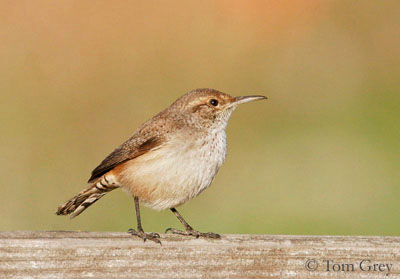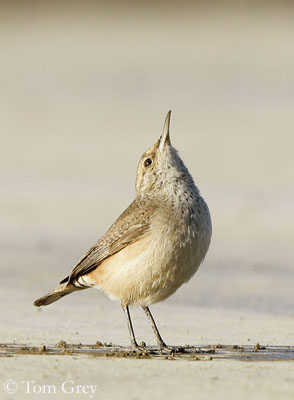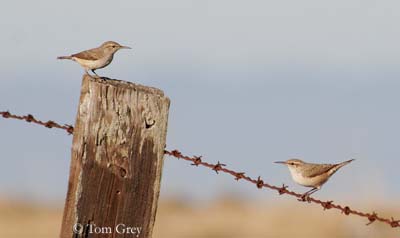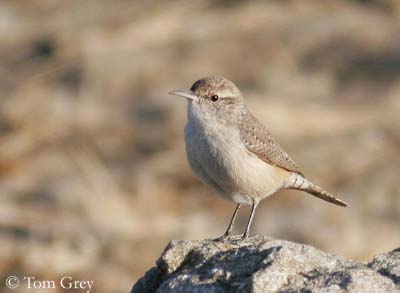
Rock Wren
Salpinctes obsoletus
Passeriforme Order – Troglodytae Family
BIOMETRICS:
Length : 12-15 cm
wingspan : 23 cm
Weight : 15-18 g
LONGEVITY : Up to 6 years
DESCRIPTION:
Rock Wren is a small songbird, with dull grey-brown back and cinnamon rump, long cinnamon tail with buffy tips on outer feathers, and a broad dark tail band. Upperparts are speckled with small white and dark patches.
Underparts are whitish, finely streaked with grey-brown on breast and throat. Flanks are washed with cinnamon. Undertail coverts are whitish barred black.
Head is dull grey-brown on crown and nape. We can see a white eye-stripe. Face is greyish, finely spotted with white and dark. Chin and throat are whitish.
Bill is long and thin, slightly down curved, with pale yellow base on lower mandible. Eyes are brown. Legs and feet are blackish brown or black.
DIET:
Rock Wren feeds mainly on insects and larvae, spiders, and also earthworms. It doesn’t drink water. Its food provides it all it needs.
PROTECTION / THREATS / STATUS:
Rock Wren species seems to be declining throughout some parts of its range. Birds are prayed upon by snakes and mammals. However, Rock Wren is currently widespread and common, even with increased incidence of nest parasitism by Brown-headed Cowbird.
Fr: Troglodyte des rochers
All : Felsenzaunkönig
Esp : Ratona de las Rocas
Ital : Scricciolo di roccia
Nd : Rotswinterkoning
Russe : Скальный крапивник
Sd : Klippgärdsmyg
Photographs by Tom Grey
His website : Tom Grey's Bird Pictures
Text by Nicole Bouglouan
Sources:
HANDBOOK OF THE BIRDS OF THE WORLD Vol 10 by Josep del Hoyo-Andrew Elliott-David Christie - Lynx Edicions - ISBN: 8487334725
WRENS, DIPPERS AND THRASHERS by Brewer David – illustrated by Barry Kent Mackay- Yale University Press - ISBN: 0300090595
BIRDS OF THE GREAT BASIN – by Fred A. Ryser - Univ of Nevada Pr -ISBN: 0874170796
A GUIDE TO THE BIRDS OF MEXICO AND NORTHERN CENTRAL AMERICA by Steve N. G. Howell, Sophie Webb - Oxford University Press - ISBN: 0198540124
All About Birds (Cornell Lab of Ornithology)
Bird Web (Seattle Audubon Society)

Both sexes are similar.
Juvenile resembles adults, but with duller colours. It is darker, with little streaks on the underparts, paler than in adults.
There are several races alive or not:
« obsoletus » from Mexico to Guatemala,
« fasciatus » in Nicaragua,
« exsul » in Mexico,
« guadeloupensis » in Guadelupe Islands,
« tenuirostris » in Baja California,
« neglectus » in Central America and Honduras,
« guttatus » in Nicaragua.

VOICE: SOUNDS BY XENO-CANTO
Rock Wren’s song is a series of varied sounds, such as buzzes, trills, chatters and whistles, often repeated several times. Male has a large sound repertoire.
Call is a buzzy “tick-ear”, or a loud, dry trill.
Its song becomes more varied and musical during breeding season.
HABITAT:
Rock Wren lives mainly in arid and semi-arid habitats, open rocky country with sparse vegetation, scrublands, loose rock slopes and broken ground areas in steppe and dry forests. It breeds in dry rocky areas such as canyons and cliffs.
RANGE:
Rock Wren breeds from southern British Columbia and Saskatchewan, to California and Texas, and through Mexico to Central America.
It winters southwards in southern United States. This species is resident in the southern parts of its range, but northern birds migrate southwards to winter.
BEHAVIOUR:
Rock Wren frequently bobs its body, mainly when alarmed. It gleans its prey from rocks, and also removes insects from spider’s webs. It also may capture flying insects by hopping vertically from the ground. It forages on the ground, probing with the bill for food, mainly insects and earthworms. They often bounce up and down among rocks while feeding. It roosts in vertical posture as a woodpecker.
During breeding season, male establishes its territory and sings from rock promontories to attract females. Pair is monogamous and solitary nester, and lasts through one season.
Rock Wren is migratory, mainly in northern areas. Birds move southwards or to lower elevations. Southern and island populations seems to be sedentary.
FLIGHT:
Rock Wren performs weak fluttering direct flights, often short and low, with shallow wing beats.
REPRODUCTION:
Rock Wren’s nest is located in crevices or holes. But this species presents a particular fact. Both male and female build a trail made with flat stones and pebbles, a kind of walkway at the entrance of the nest. They build this trail before the nest itself, probably for drainage. It may size up to 25 cm.

Nest is cup-shaped, and built inside the crevice or the hole. They create a foundation with stones, and female builds a loose cup on the top. Cup-shaped nest is made with grasses, wood, bark, hair, and silk from spider’s webs. Male helps female bringing nest materials. Interior is lined with softer matters.
Female lays 5 to 6 glossy white eggs, finely spotted of reddish-brown. Incubation lasts about 14 to 16 days, by female alone, occasionally fed by the male. Altricial chicks are fed by both parents during about two weeks. Young fledge at about 14 to 16 days of age, and parents feed them for about a week.
At this time, young become independent for food, but they remain for about one month in the parents’ territory.
This species may produce two to three broods per year.
